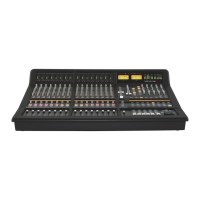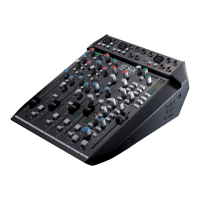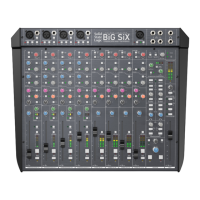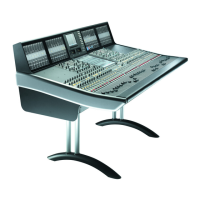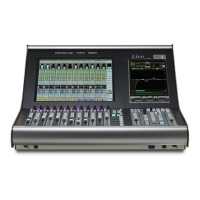GGrroouupp CCoonnttrrooll FFaaddeerrss
The console centre section features eight control group master faders.
Each group master fader may control a number of slave channel faders.
Additionally, group master faders may control other group master
faders.
Two modes of fader grouping are available: VCA and Servo: In Servo
mode, moving the master fader will cause the slave faders to move.
VCA mode grouping emulates a traditional non-moving fader grouping
system — moving the group master changes the gain of the slaves but
doesn’t physically change the position of the slave faders. The gain
equals the gain of the slave plus the gain of the master (in dB). Assigning
a fader to a group immediately changes the gain by the amount the
master is displaced from 0dB. The mode is defined by the Fader
Grouping Mode: entry in the SSL / Misc / Setup menu.
If you load a mix created in one grouping mode while the other
grouping mode is active, the mix levels for playback will be
automatically corrected for the current mode.
When in Servo mode the Group Lockout level: entry in
the SSL / Misc / Setup menu allows you to set a group
master level below which slave faders will not have their balance
altered. The lockout level range is -35dB to -70dB or OFF.
Unlike previous SSL analogue consoles, the servo grouping mode
allows faders to be added to and removed from groups without
changing levels.
Note that you cannot switch modes during a mix!
Group assignments may be stored as part of a Total Recall (option) setup.
Selecting channel faders to a group is simple — press the select buttons of the channels you want to include in
the group then, in the centre section, press the group button at the foot of the required group fader (see right).
The group display on each fader will reflect your choice.
To assign a group master to be controlled by another group master, press the group button on the group master
to be controlled (ie. the slave), and while keeping this button pressed, press the group button on the group master
that will control the slave. Use the same procedure to deselect an assigned master from the slave group.
Pressing the CUT button on a group master fader will have the same effect as pressing the CUT buttons on all
the slave faders. The underlying state of these functions on slave faders can be changed while a group master CUT
is active, but the group master CUT state can not be overridden by the local function. Group fader CUT buttons
may be automated if the optional automation system is active. See Section 5 for more details.
Similarly, when in SIF, AFL or PFL solo modes, pressing the SOLO button on a group master fader will have the
same effect as pressing the SOLO buttons on all the slave faders. However, in default (solo-in-place) solo mode,
group solos work slightly differently: pressing the SOLO button on a group master fader will result in all channels
not in that group being cut. This means that pressing the SOLO button on a fader within that group will cause the
other faders within the group to be muted, overriding the group SOLO button.
22--4400
CCoonnssoollee OOppeerraattiioonnss
DDuuaalliittyy SSEE OOppeerraattoorr’’ss MMaannuuaall
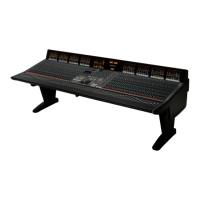
